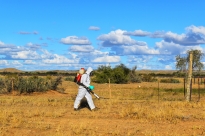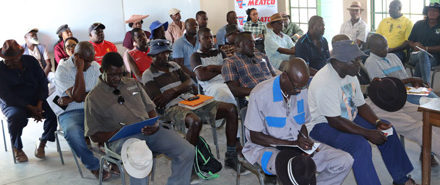
Five-fold increase in mahangu

Conservation tillage starts when the land is prepared for planting. It has a dramatic impact on yield. (Photograph courtesy of CES/CLUSA)
According to von Hase’s findings, the traditional farming methods of using disc harrows or board ploughs pulverize and compact the soil resulting in crops being exposed to wind, floods and droughts and lead to dismal Mahangu yields of only 230 kg per hectare.
He said a new type of farming technique known as the Namibia Specific Conservation Tillage (NSCT), was recently introduced and many farmers are now adopting this technique.
Conservation tillage relies on a simple set of techniques that have been developed together with communal Mahangu farmers in the four northern regions. Farmers make use of rippers instead of disc harrows or board ploughs. This method improves yields and stabilizes them against droughts, floods and high winds. “It is considered to be a Conservation Agriculture technique and it boosts average mahangu yields to 1670 kg/ha” said von Hase.
The study was conducted by interviewing 13 conservation agriculture farmers, 3 non- conservation agriculture farmers, 2 extension officers, 1 regional counselor and 1 tractor owner. Interviews were held at homesteads and in offices in and around Ondangwa from January to March 2013.
“The reason why this study placed emphasis on the opinions of farmers was that it aimed to facilitate increased adoption of conservation agriculture, thereby improving subsistence livelihoods. Only by listening to farmers describing their problems will it be possible to derive appropriate solutions to help improve their lives,” he said.
Through the interviews, it was found that farmers held positive attitudes towards conservation agriculture and therefore had the intention to adopt it. This was mostly because of easier weeding and better yields, even in drought years. Farmers found it easy to learn about conservation agriculture and to implement it and they felt empowered by its results. As a whole, farmers had strong intentions to adopt conservation agriculture, von Hase indicated.
The availability of tractors for ripping the land however posed a problem to the farmers. This prevented most farmers from adopting conservation tillage even though they wanted to. Generally, most farmers agreed that the better ploughing helped them to have enough food and to sell some.
“Farmers often decided to try conservation agriculture immediately upon hearing about its better yields, but they adopted it in increments to limit their risks if the method should fail. Failure of conservation agriculture was however not reported by farmers,” he said.
Although the method was introduced to farmers in 2005, it was found that by the end of 2011; only about 800 farmers were using the technique. Therefore, according to von Hase, there is a dire need to upscale the adoption of conservation agriculture across Northern Namibia where around 230,000 households derive their income from subsistence farming.
Conservation tillage is now promoted through the Namibia Conservation Agriculture project implemented by CLUSA and funded by USAID.













































